23 Abandoned Places in CALIFORNIA (Cool & Creepy)
When someone says California, you immediately associate it with the glitz and glamor of Hollywood.
It is often called the Sunny State, the Golden State, the Golden West, and so much more!
Despite the overall happy disposition and brightness brought by these A-list stars and productions, the state is also known for its abundance of dark, abandoned places.
With how fast-paced things are in California, it is inevitable for massive infrastructures to become outdated and abandoned.
If you’re more into this side of tourism, this article provides informative background for the abandoned places you can explore whenever you visit California.
Be advised: it’s best to scroll through the list with tissues and an emotional support blanket in hand.
And by the way, you may also want to check out the best Outdoor Activities in California.
Abandoned Places in Los Angeles, California
1. The Old L.A. Zoo (Opened 1912; Closed 1966)
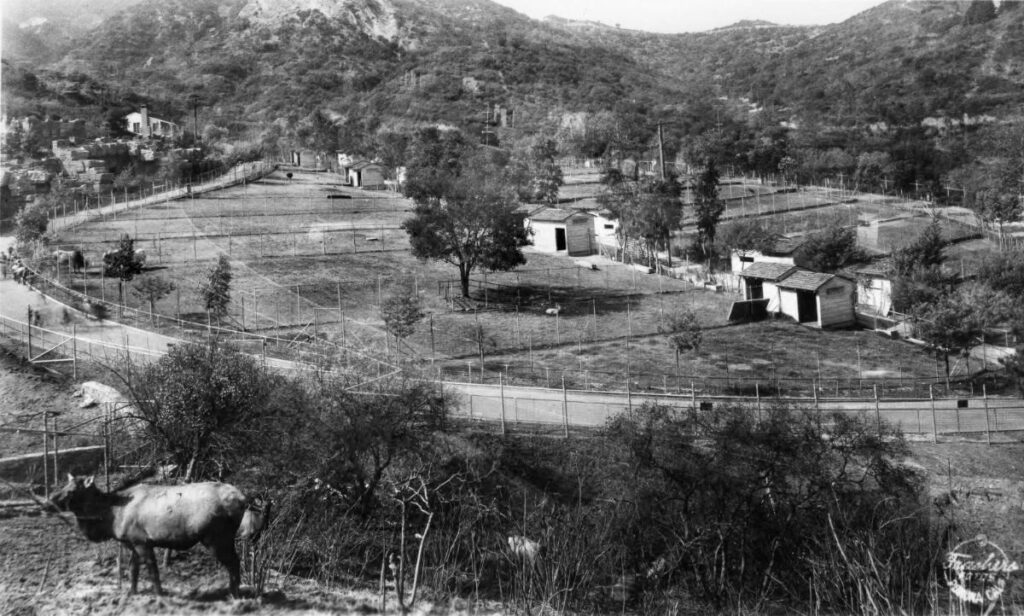
Established by the city of Los Angeles, the Griffith Park Zoo, most commonly known as the Old LA Zoo, opened its doors to the public in 1912.
The zoo is no stranger to being abandoned, though, as it stands on the property of Griffith J. Griffith’s abolished ostrich farm.
Although a small zoo with only more than 15 animals, the zoo faced quite a few crises over the years.
The lions were diagnosed with a highly contagious disease called glanders; there was an issue with the sewage dumping into the Los Angeles River; meat-eating animals died due to a beef ban during WWI, and by 1923, the zoo had become dilapidated
As the population in Los Angeles grew, the zoo drew flack for being poorly designed and managed.
With that, the city passed an $8 million bond to create a new zoo, which led to the official closure of the old zoo in 1966.
Address: Griffith Park Dr, Los Angeles, CA 90027
2. Murphy Ranch (Nazi Sympathizer Hideout)
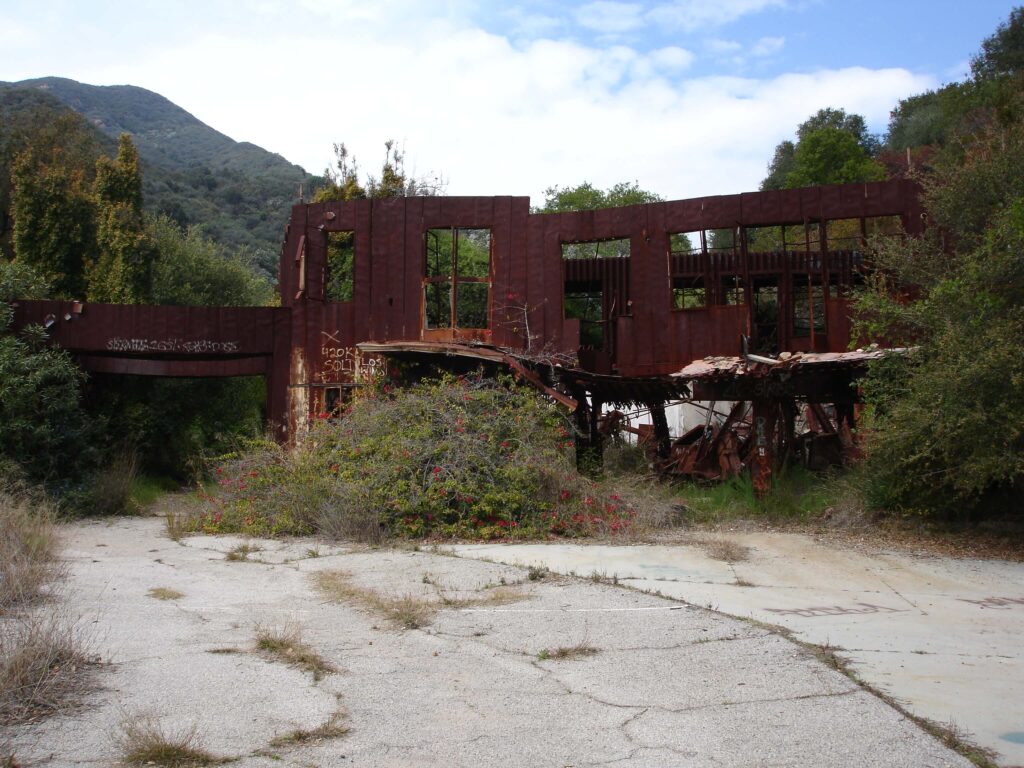
Murphy Ranch is an excellent place to start if you want to get into the dark history of California.
Jesse Murphy, believed to be a pseudonym, built the estate on a secluded 55-acre land to nurture Nazis and lead the new fascist state in America after WWII.
Those plans were completely squashed after the Pearl Harbor attack when authorities swept the area and arrested most residents.
In 1948, the Hartford Artists’ Colony bought the land, but the city of Los Angeles later bought it in 1973.
The majority of the buildings in the ranch were deemed unsafe and, thus, demolished.
There are remaining buildings, like the powerhouse, but entryways remain sealed to this day.
Address: Sullivan Fire Rd, Pacific Palisades, CA 90272
3. The Sunken City (Landslide Submersion)
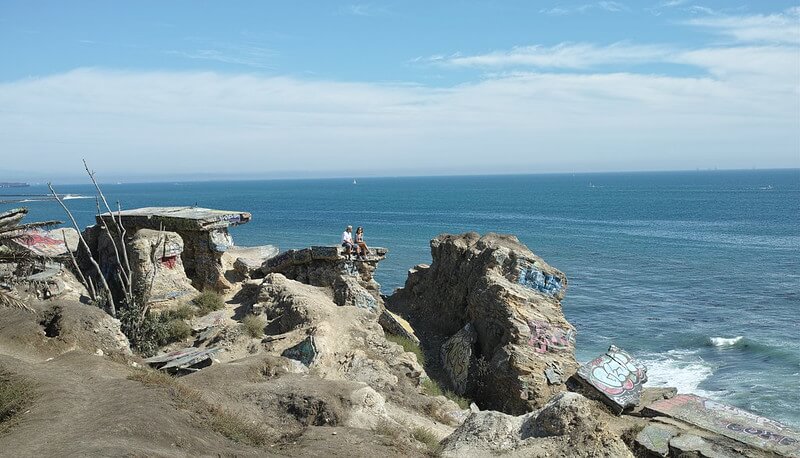
Sometimes, marvelous things disappear from the face of the earth due to natural disasters, just like the legend of Atlantis.
Sunken City has suffered the same fate as Atlantis, where a natural phenomenon- a landslide, caused beach houses, rail tracks, and streets to tumble into the ocean.
The cause for such an ill fate was a gradual landslide, which caused the land to move at 11 inches daily.
Despite its unfortunate history, the site has become a famous spot not only for tourists but also for tagging crews and stoners.
But neighboring residents quickly report trespassers to authorities; trespassers receive a $450 fine for the violation.
Address: Paseo Del Mar, Los Angeles, CA, 90731
4. Lincoln Heights Jail (Anti-Sodomy Arrests)
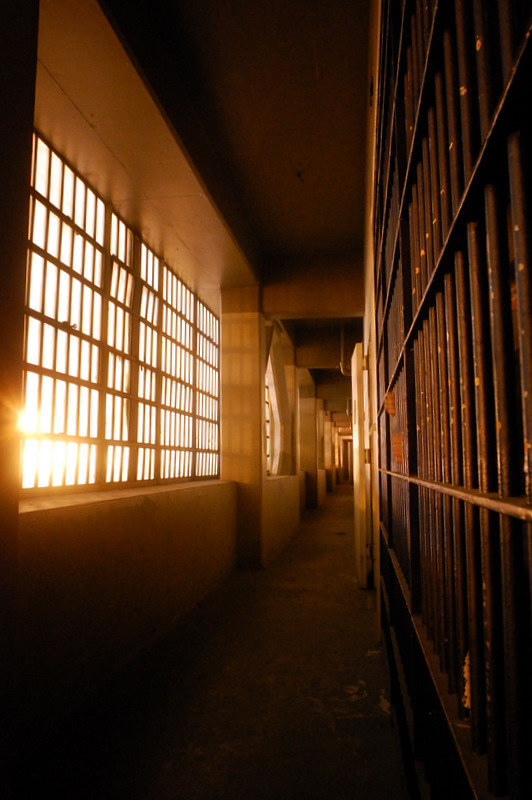
Lincoln Heights Jail sits abandoned today adjacent to the Los Angeles River and the traffic-congested I-110 and I-5.
The city built the jail complex in the 1930s to house 600 convicted criminals, but it regularly exceeded its maximum capacity.
In the 1950s and 1960s, the jail was also used to incarcerate “criminals” based on LAPD Chief William Parker’s anti-sodomy laws, which also targeted the majority of the LGBTQ population.
Sitting in stark contrast with the bustling buildings in proximity, the LA County Board of Supervisors and Los Angeles City Council decided to decommission the jail in 1965 due to financial and practical reasons.
Although there were plans to make the jail complex a multi-use development in 2017, the economic challenges of needing to clean out hazardous debris and expensive renovations caused the abandonment of the building.
Address: 421 N Ave 19, Los Angeles, CA 90031
5. Hawthorne Plaza Mall (Opened 1977; Closed 1999)
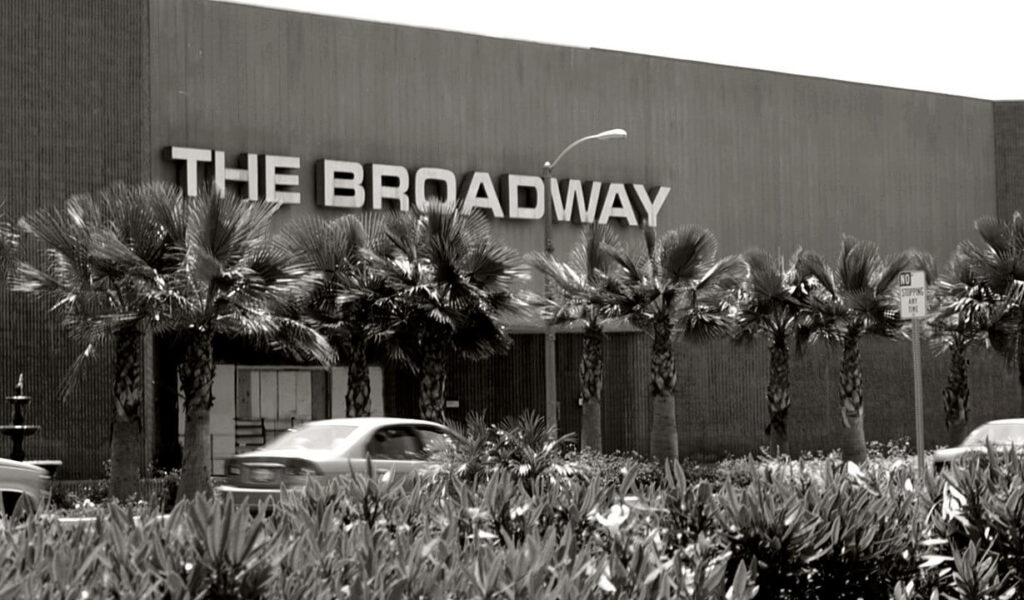
Hawthorne Plaza Mall opened 134 stores in February 1977 as part of the Hawthorne Plaza Redevelopment Project.
The 800,000-square-foot plaza majorly catered to the middle-class residents in Hawthorn and its surrounding areas with cheaper stores, contrary to nearby malls.
The mall declined with the shooting incident in 1979, which worsened during the cutback of aerospace-related employment in the 80s and 90s
There was a gradual closure of the stores that occupied the mall, from 130 stores down to 70 in 1998.
Once the mall’s anchor, JCPenney, closed in 1998, the mall followed suit and shut down its operations in 1999.
There were plans to renovate and revitalize the mall into a “power center,” including a mini-mall, office complex, walkable retail strips, and high-end housing.
However, the mall remains abandoned as the owner received a four-year sentence for bribery.
Address: Hawthorne, CA 90250
6. Rockhaven Sanitarium (Built by Women for Women)
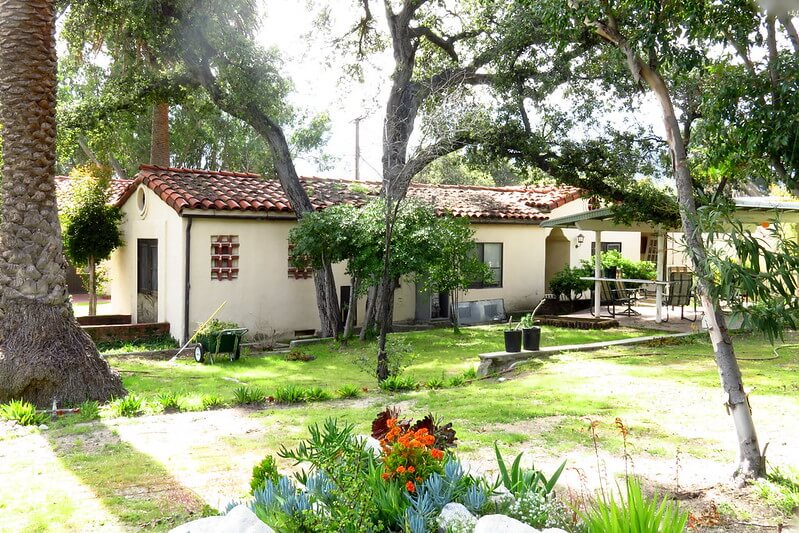
Rockhaven Sanitarium is an excellent example of one of the first institutions built by women for women.
Agnes Richards, R.N. had the vision to provide small but impactful movements to improve the treatment of mentally ill women during the 20s.
The sanitarium was dubbed the Screen Actors’ Sanitarium, where celebrities sought treatment, like Gladys Pearl Baker—the mother of Marilyn Monroe, Billie Burke, Peggy Fears, Josephine Dillon, and others.
When Richards passed in 1967, her granddaughter Patricia Traviss was in charge, which directed the trajectory of the sanitarium to become popular for the care of dementia patients.
In 2001, Traviss sold the facility to Ararat Home of Los Angeles, but they eventually sold it to the city of Glendale due to the costly upkeep.
The facility was listed in the National Register of Historic Places in 2016 and currently serves as a landmark for feminism.
Address: 2713 Honolulu Ave, Montrose, CA 91020
Also see our article on Indoor Activities in California.
Abandoned Places in San Diego, California
1. Old California Theater (Opened 1927; Closed 1990)
The Old California Theater started its operations on April 22, 1927, with the Venus of Venice, Book Ideas, and Al Lyons and His Band as the opening salvo.
The theater seated over 2,200 patrons in its Spanish-style architecture with a wrap-around balcony and intricate ceilings, murals, and ornaments.
The building was renovated in 1988 to restore it to its original glory, but the owner defaulted on loan payments, which resulted in its official closure in 1990.
There has been a push and pull on what awaits the building for quite some time; the San Diego City Council voted to demolish the theater in 2017.
However, Save Our Heritage Organisation (SOHO) posted a legal challenge to the decision, which led to the $21.1 million deal in 2020 with hopes of restoring it using much of the original ornamentation.
Address: 1122 Fourth Ave, San Diego, CA 92101
2. The Chargers Facility (Abandoned Since 2010)
Also known as Chargers Park, the Chargers Facility was the headquarters for the NFL team San Diego Chargers before they bolted and left for Los Angeles.
The team previously used Qualcomm Stadium as its training facility and venue for home games.
The city of San Diego suffered a massive debt from the team’s decision to move to LA since they lost tourism revenue and are still paying for maintenance and utilities of the facility.
However, despite being abandoned in 2010, the stadium remains solid and semi-functional, with sprinklers still running and electricity still alive.
There are talks that the city might renovate and revitalize the facility, but they’re still rumors today.
Address: 4020 Murphy Canyon Rd, San Diego, CA 92123
3. Horton Plaza Mall (Opened 1985; Closed 2020)
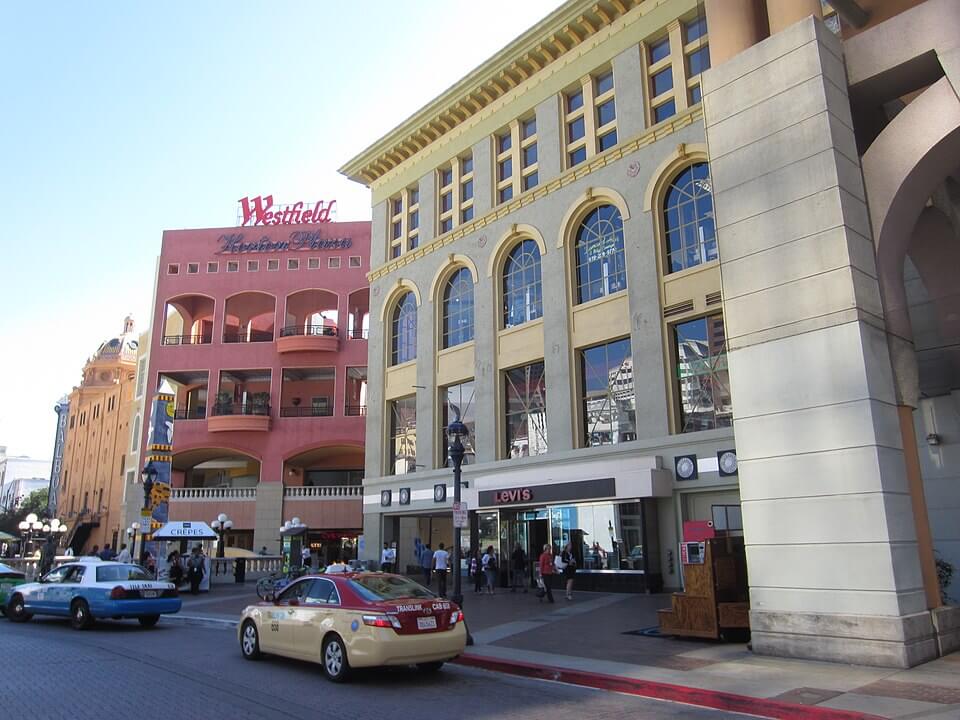
Unique architecture was famous in the 80s and 90s, and Horton Plaza Mall is a testament to the experimental nature of architecture during that time.
The mall was said to have been based on experience architecture, which meant that it had mismatched levels, long one-way ramps, sudden drop-offs, and brightly painted façades.
The Hahn Company was responsible for building the mall under the redevelopment project in an attempt to revamp the historic town plaza of San Diego.
Named after the developer of downtown San Diego, Alonzo Horton, the mall has been a financial success since its grand opening in 1985.
However, the mall slowly faded into the background as its stores closed one by one, followed by unfortunate events on the premises.
The mall’s demolition began shortly after Macy’s closed business in April 2020 and is moving forward to bring forth The Campus At Horton.
Address: 324 Horton Plaza, San Diego, CA 92101
4. Goat Canyon Trestle (Closed Indefinitely in 2008)
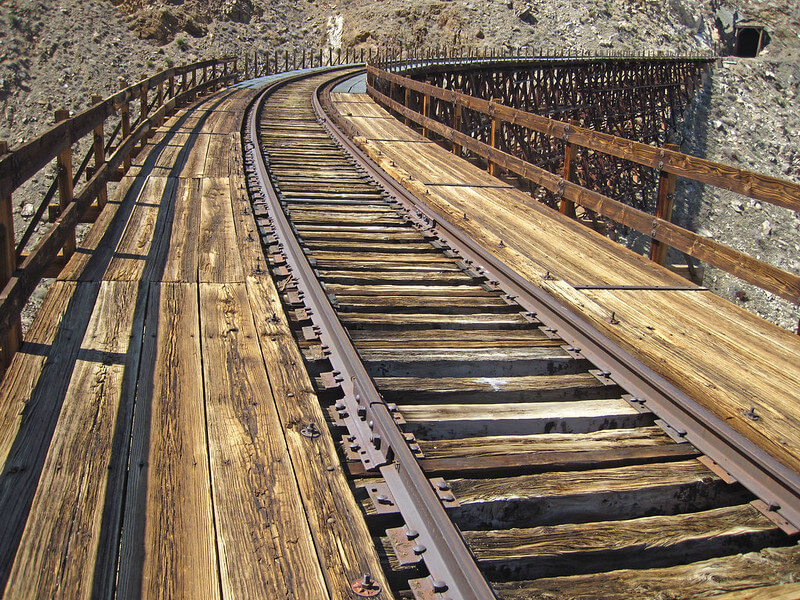
The construction of the impossible railroad, Goat Canyon Trestle, started in 1933.
The railroad ran across the Colorado Desert and the Jacumba Mountains, and its completion in 1919 meant another railway access to San Diego aside from the Los Angeles tracks.
The bridge has encountered a lot of mishaps, even during its construction, from natural disasters like hurricanes and earthquakes to a decrease in railway interest due to increased automobile transit.
In 2008, the desert line was closed indefinitely for repairs, ending the glorious era of the trestle.
In 2018, Baja California Railroad assessed the line’s condition with the hopes of reopening the line.
But because of the severe damages, they abandoned all hopes of reopening the railway in 2021.
Rumor has it that the abandoned tracks and train cars are now home to glowing orbs and an abominable sandman!
Address: Anza-Borrego Desert State Park
Also see our article on Attractions in California.
Abandoned Places in Stockton, California
1. The Henery Apartments (Built 1913; Abandoned)
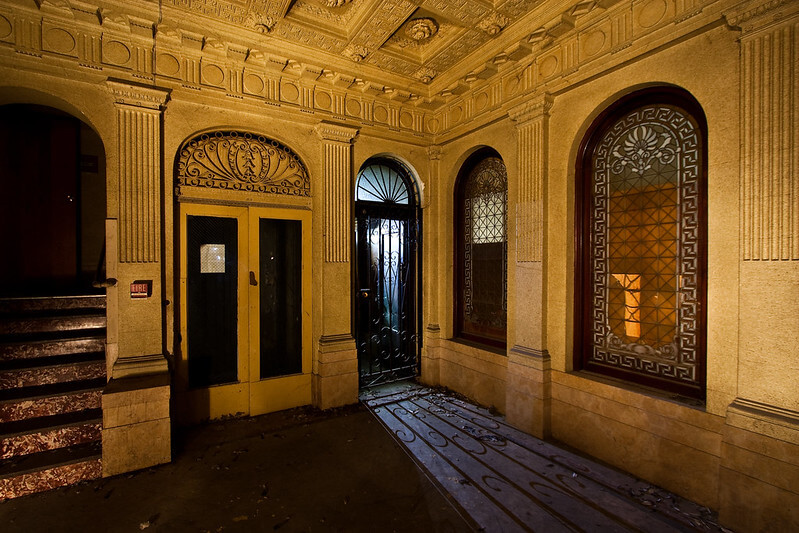
Stockton’s well-known architect, Glenn Allen, had the vision to build a luxurious apartment for the affluent families of Stockton; he led the construction of the Henery Apartments in 1913.
A massive fire engulfed several floors, causing costly damages to the interior and exterior façade; the management deemed the repairs and renovations impractical, hence, its closure.
After its first closure, the city of Stockton purchased the building to provide housing for low-income housing, but this plan never pushed through.
The building was also used as practice grounds in the early 2000s by the city’s SWAT Team, but they abandoned it after completing their training course.
It is now a famous spot for urban explorers as it is considered one of the oldest abandoned buildings in the state.
Address: 121 S. Sutter St., Stockton, CA 95202
2. Fire Engine House No. 6 (Firehouse, Asbestos Contamination)
What started as a bustling firehouse in the heart of Stockton now sits as an abandoned building.
Fire Engine House no 6 was previously housed on the property built by Holt Manufacturing Company at 527 S. Aurora & Hazelton.
The company entered into a leasing contract with the city of Stockton to build, house, and partially provide equipment for a fire company in 1917.
The city would own the company’s building and equipment three years after the contract.
However, the firehouse would have to relocate to the Victory Park site at 1501 Picardy Lane to provide services to the growing westerly residential and businesses.
There were plans to reuse the building in 2014, but it did not come to fruition because of asbestos contamination.
And in 2021, a fire broke out in the building, and there are still no plans to restore or renovate it.
Address: 527 S. Aurora & Hazelton
3. Pollardville (Staged Ghost Town)
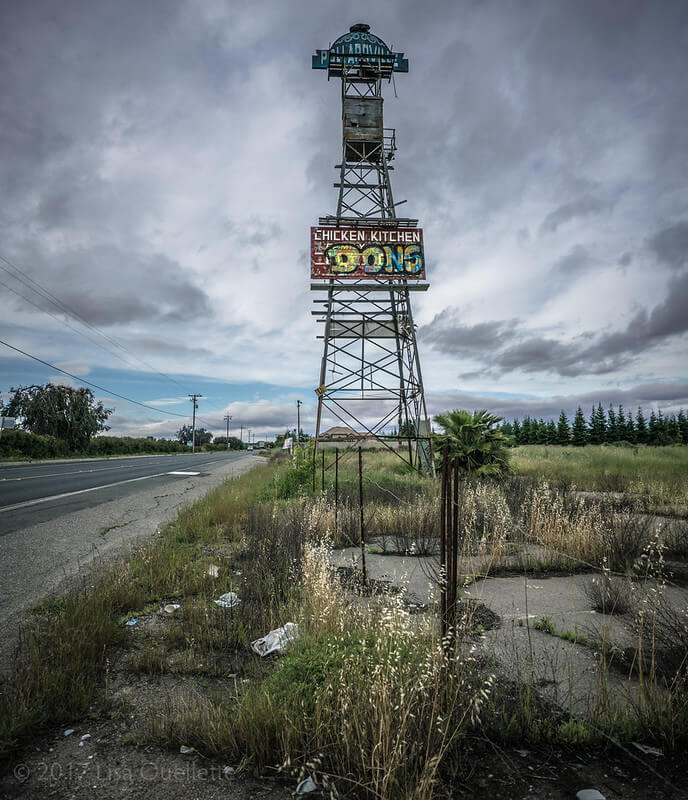
Time travel back to the 2000s; you’re heading down or going out of Stockton on Highway 99; it’s hard to miss the massive sign with its chicken mascot: ah, Pollardville.
Staged as a ghost town, the Pollards—owners of the complex and restaurant, had an appreciation for antique things.
Pollardville started as the Chicken Kitchen Restaurant in 1944 at the Red Gate Farm Chicken Ranch in Castro Valley, which relocated to its former location along Highway 99.
After 60 years, the family retired from the business in 2006, demolishing all the structures in the area.
What once was a place for staged gunfights and much-loved fried chicken is now a vacant lot with only its sign staying intact.
Address: 10464 N Hwy 99, Morada, CA 95212
4. Preston School of Industry (Abandoned Since 1960)
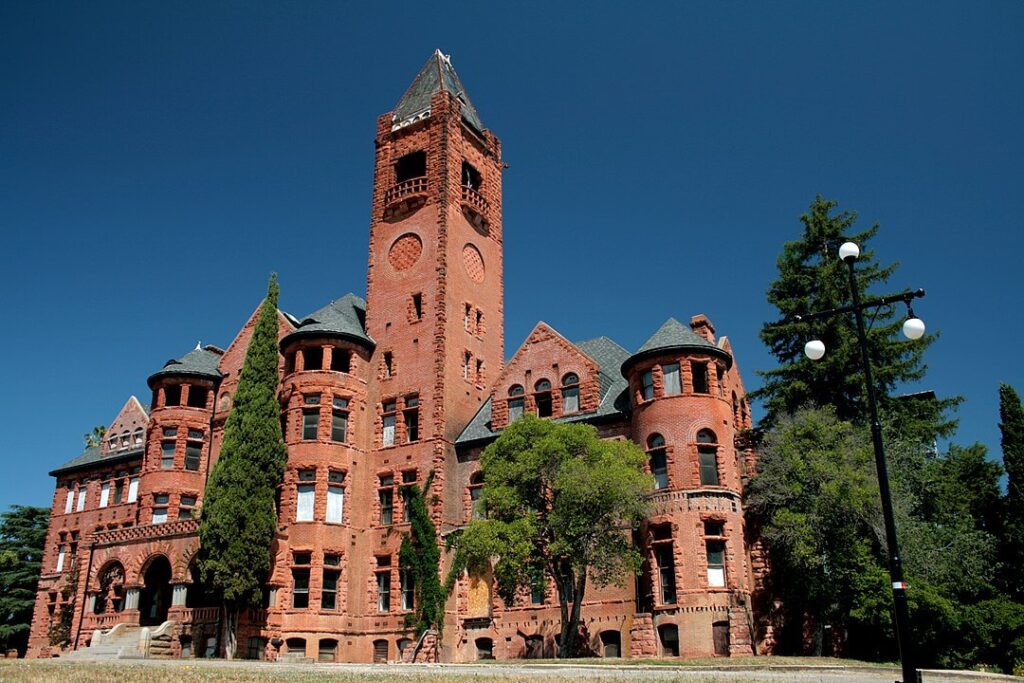
Preston School of Industry, colloquially known as Preston Castle, was a reform school for boys established in 1894.
When it opened, the school had seven minors under its care; it is considered one of the oldest reform schools in the United States.
Using a Romanesque Revival architecture style, the state built the school to make it appear more like a school instead of a prison.
The castle, the school’s administration building, was abandoned in 1960 as the administration developed facilities to replace it.
A local women’s organization fought to keep the castle intact when there were plans to demolish it; it is now a California Historical Landmark and listed on the National Register of Historic Places.
Today, you can attend the scheduled tours and events to help raise funds for the castle’s preservation and rehabilitation.
Address: 900 Palm Dr, Ione, CA 95640
Also see our article on Construction Companies in California.
Abandoned Places in Bay Area, California
1. Treasure Island (Naval Base; Popular Film Location)
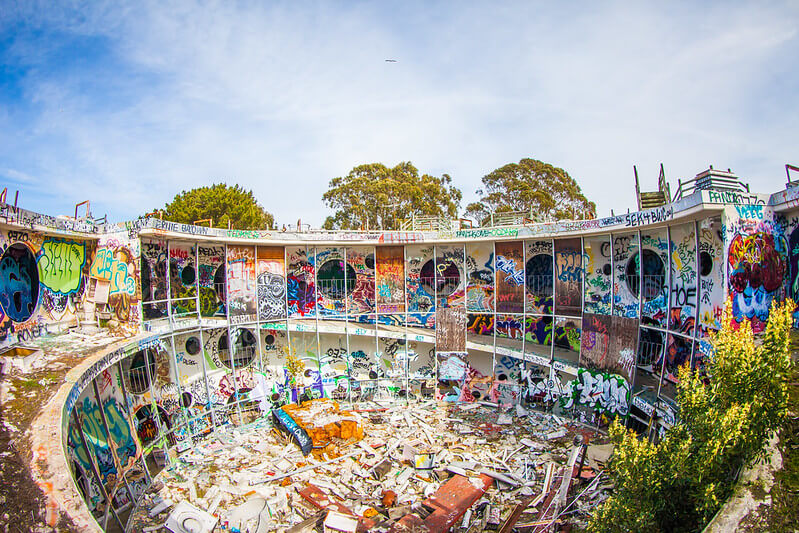
Treasure Island is a 400-acre artificial island lodged between San Francisco and Oakland.
The Army Corps of Engineers built the island in 1936-37 with mud dug from the bay to host the 1939-40 Golden Gate International Exposition.
After the expo, the US Navy used it as a Naval Auxiliary Air Facility where ships were cleaned and decontaminated, causing radioactive materials to seep into the soil on the island.
The Navy base closed in 1997, allowing Hollywood to use it as a popular shooting location for movies like Charlie Chan at Treasure Island.
Today, the island has properties for rent, but some abandoned buildings are still famous among urban explorers and tagging crews, like Cosson Hall.
The hall is famous for its unique asterisk-like shape and the horror stories where explorers can allegedly hear the whistling of the US Navy’s unofficial song—Anchors Away.
Address: San Francisco, CA 94130
2. Fleishhacker Pool (Closed in 1971; Demolished)
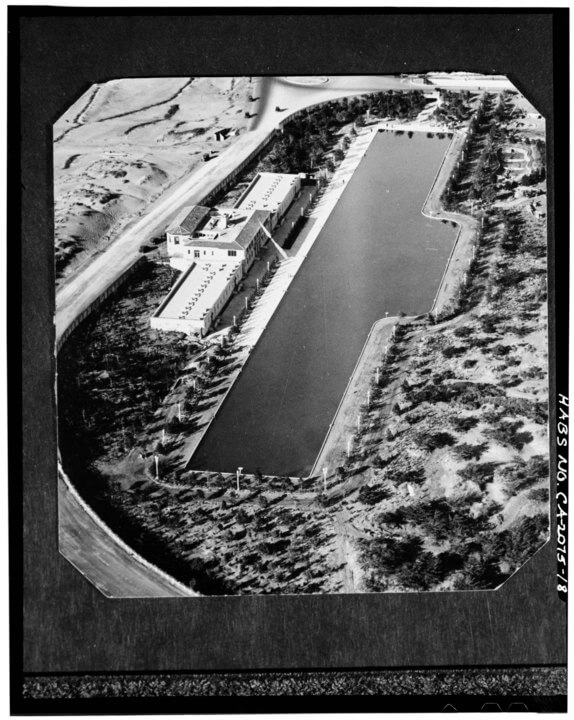
Fleishhacker Pool was one of the largest outdoor swimming pools in the world in 1925.
The public saltwater pool was next to the San Francisco Zoo at Sloat Boulevard and the Great Highway.
The pool was 1,000 by 150 feet big and had a diving pool that was 14 feet deep; it was so enormous that lifeguards used row boats to patrol it.
A storm in January 1971 started its decline by damaging its drainage pipe, but it was mainly due to the poor maintenance and underfunding of the facility.
There were plans to reopen the landmark, but with operating costs higher than the revenue, it was a no-go.
A fire broke out in the pool house in December 2012, causing the destruction and demolition of the ruins.
Today, the pool is filled with rocks and gravel, serving as a parking area and access road for zoo employees.
Address: Sloat Boulevard and Great Highway
3. Sutro Baths (Largest Indoor Pool)
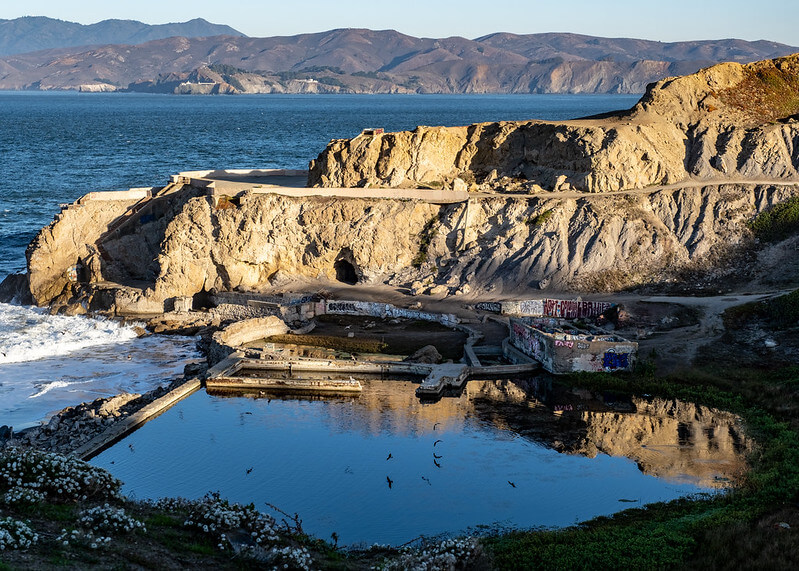
If Fleishhacker Pool was the largest outdoor pool, Sutro Baths’ was the largest indoor pool.
The millionaire and former mayor of San Francisco, Adolph Sutro, developed the swimming facility in 1894 to cater to the people of San Francisco and provide them with an affordable recreational swimming pool.
Adolph Sutro’s descendants continued the legacy of the Baths, including the Cliff House, but it became less popular during the Great Depression; plus, they had a difficult time complying with the new health codes.
The family converted the pools into skating rinks to make it profitable, but the efforts were futile, leading to its sale to developers in 1964.
Now, the pools and ruins of the Cliff House’s north side are part of the Golden Gate National Recreation Area.
Address: 1004 Point Lobos Ave, San Francisco, CA 94121
4. Bayshore Roundhouse (Closed in 1982)
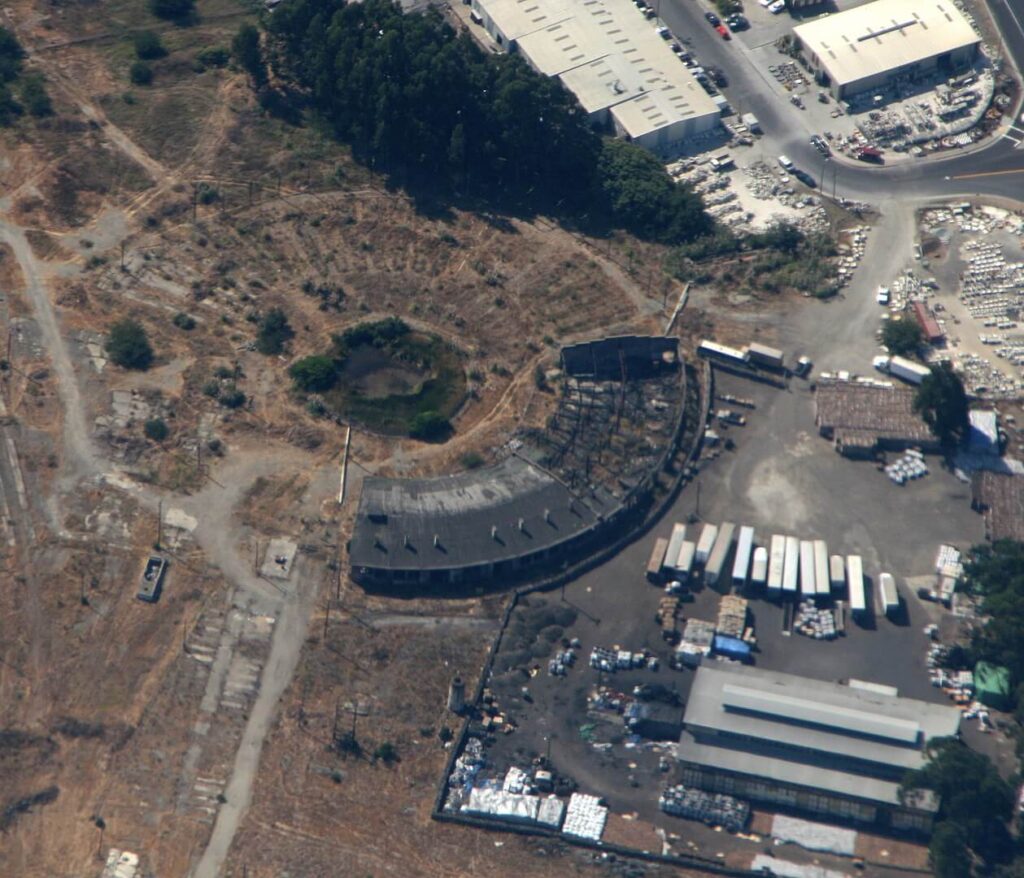
If you didn’t know, a roundhouse is a circular repair shed for trains centered on its turntable.
Southern Pacific built Bayshore Roundhouse in 1907, which consisted of five tunnels; it mainly serviced freight trains.
Although there were more than 200 roundhouses in California in the early 1900s, only one brick roundhouse barely remains.
As diesel engines gained popularity, the fate of the roundhouse was leading to obsolescence since the trains required less maintenance.
Bayshore tried to continue operations, but after decades of seldom use, the roundhouse officially closed in October 1982.
Although most of the surrounding buildings were razed, half of the roundhouse remains intact.
Address: 2800 Bayshore Boulevard, Brisbane, California 94005
Also see our article on Hiking Trails in California.
Abandoned Places in Oakland, California
1. Oak Knoll Naval Hospital Base (Closed in 1996)
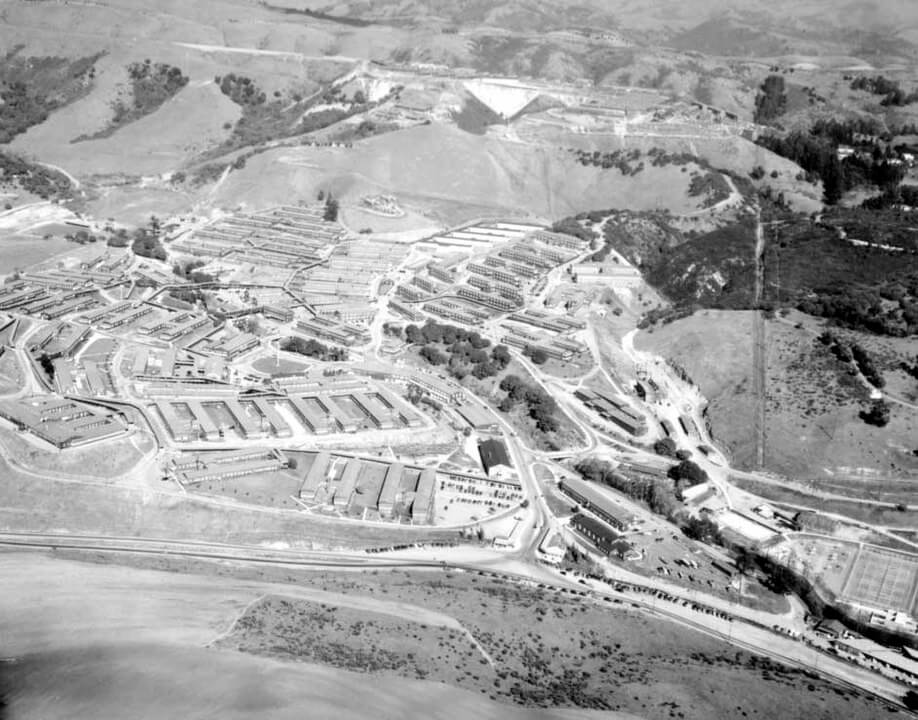
Oak Knoll Naval Hospital Base sat on a 167-acre land bordered by Mountain Boulevard and Keller Avenue.
The hospital opened during World War II in 1942 to treat wounded American military personnel in the Pacific theater; later, it also treated wounded personnel during the Korean and Vietnam wars.
When the Naval base shut down in 1996, the hospital stopped its operations.
In 1996, SunCal began planning a redevelopment program incorporating a mixed-use residential community.
The last building standing in the complex is the Club House, which will be the community center of the new community.
Address: 8750 Mountain Blvd, Oakland, CA 94605
2. J’s Amusement Park (Plans for Glamping Resort)
Founded by Jay Skaggs, J’s Amusement Park rose to fame with several attractions, including a roller coaster, a mad mouse, and a mini race track.
The amusement park sadly had to close in 2003 due to the high upkeep costs.
But the Skaggs family reopened a portion of the property to create a camping ground called The Camp Outback.
The camping grounds were famous among outdoor enthusiasts with zip lines, hot tubs, fire pits, large showers, etc.
The property is still a venue for significant events within the area, such as Lazy Bear Weekend.
As for the amusement park, there were plans in 2019 to build a glamping resort.
Address: 16101 Neeley Rd. Guerneville, CA 95446
3. 16th Street Train Station (Decline in Rail Travel)
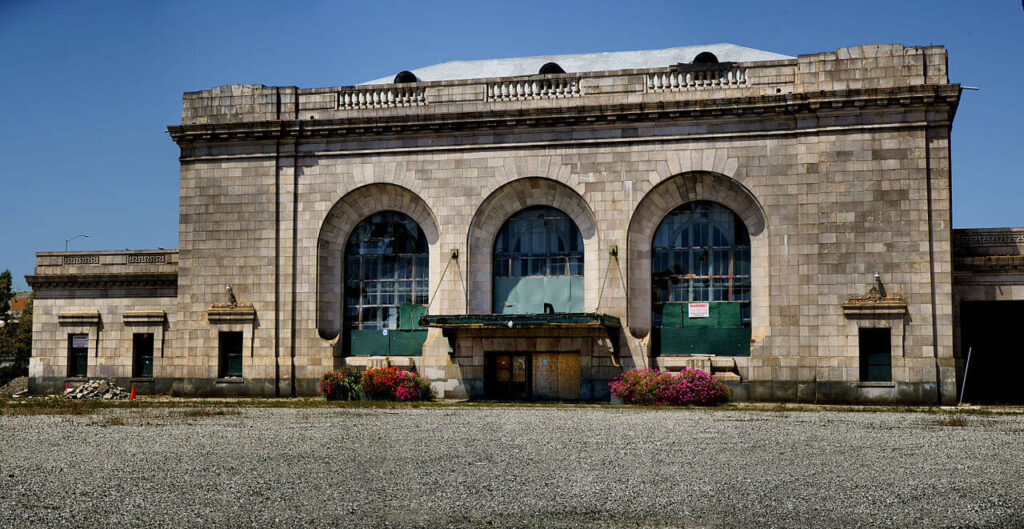
Also known as Oakland Central, the 16th Street Train Station is in the neighborhoods of Prescott, Oakland.
What started as a one-story wooden station became a unique brick building with touches of Beaux-Arts in 1912.
For years, the station was the central Oakland station for the Southern Pacific railroad, which was also known for having the first African-American union in the country.
The station also had the first multi-level train tracks west of Mississippi.
However, with the decline in rail travel affected the station, but the earthquake in 1989 that brought extensive damages was the nail to the coffin.
Now, production companies use it for music videos and movie sets.
Address: 16th Street Station, Wood St, Oakland, CA 94607
4. Kaiser Quarry Ruins (Caldecott Tunnel Construction Site)
If you stumble into Mazzariello Labyrinth, you should head further down to the Kaiser Quarry Ruins.
The quarry extracted sand and gravel, which supplied the construction of the Caldecott Tunnel between 1929 and 1937.
It was later redeveloped to become Round Top Park in 1936 and renamed Sibley Regional Volcanic Preserve.
The Mazzariello Labyrinth is in the middle of the old quarry, that’s why the ground is exposed, and trails are more accessible.
Crumbs of what used to be a successful quarry are dilapidated structures, such as wooden stables and concrete roads, and abandoned cars that you can see for yourself when visiting.
Address: 6700 Skyline Blvd, Oakland, CA
5. Kaiser Convention Center (Under Rehabilitation)
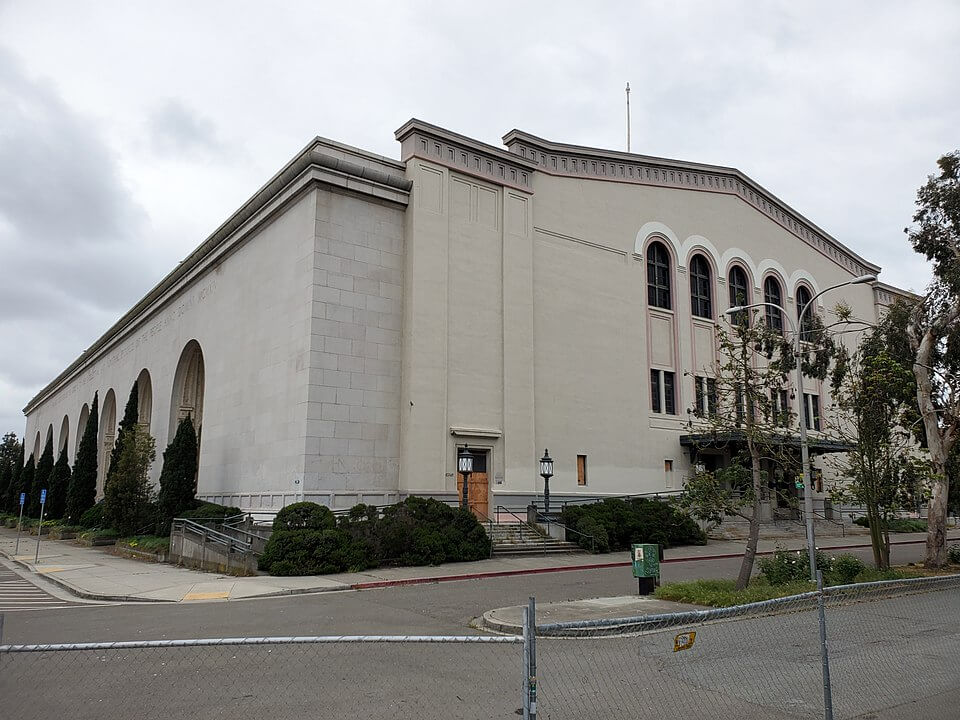
Not-so abandoned Kaiser Convention Center is a multi-purpose building located in the heart of Oakland, next to the Oakland Museum, Laney College, and the Lake Merritt BART station.
To honor Henry J. Kaiser, the Oakland Civic Auditorium was renamed Kaiser Convention Center in 1984.
The building included a large arena, theater, and ballroom.
With its massive capacity, the auditorium became an unofficial infirmary during the flu pandemic in 1918; it hosted large events, such as the Ringling Brothers and Barnum and Bailey Circus and Roller Derby.
However, with the costly maintenance and repairs, the auditorium closed in 2006.
All hope is not lost, though, as the city was able to enter into a lease with Oakland Civic, LLC.
They’re aiming to complete the rehabilitation in the spring of 2023.
Address: 10 10th Street, Oakland, California
If you liked this article, you may also like to read about the best Indoor Activities, Outdoor Activities, and Cheap Weekend Getaways in California.
Looking beyond California? Check out our article on Abandoned Places in Texas and Florida.
